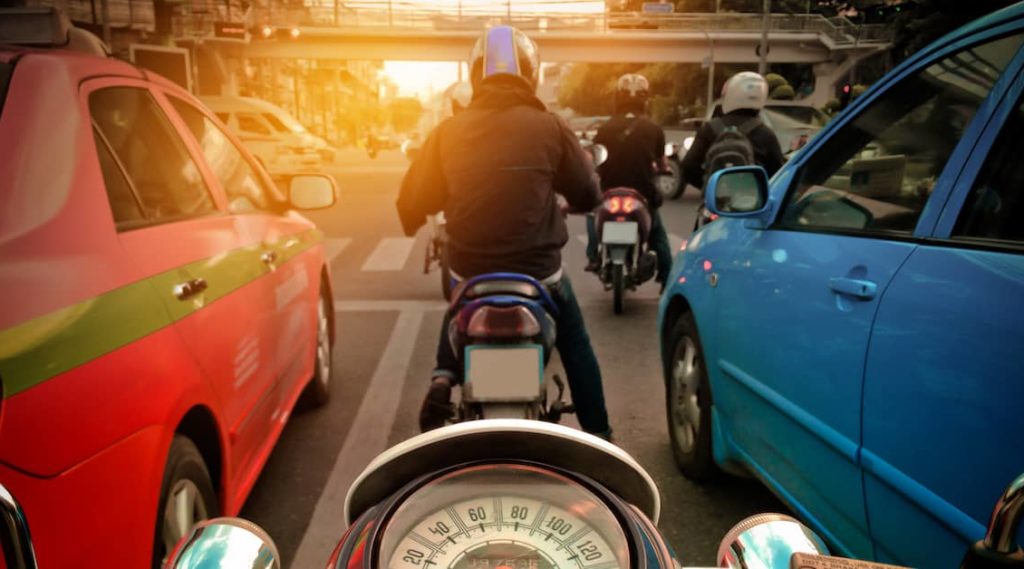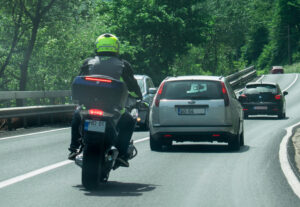
Lane splitting is a maneuver that a motorcyclist may use when traffic slows or stops to increase their safety and move quicker past slower or stopped vehicles. California law permits lane splitting under certain conditions, so drivers should be prepared for the possibility of lane-splitting motorcyclists in our state.
However, just because lane splitting is legal does not automatically mean a driver is liable for every lane-splitting accident. Like any motorcycle accident case, there will likely be complications when determining fault for a crash, as insurance companies often try to blame the motorcyclist. Never accept wrongful blame for a collision just because you were lawfully lane splitting.
After suffering an injury in a motorcycle accident, you should consult an experienced Bakersfield Motorcycle accident attorney. If the accident was the driver’s fault, you may have the right to substantial financial compensation for your injuries. Still, you must battle your way through bias and blame from insurance companies before you can receive the settlement you deserve. Hiring an attorney often gives you a better chance of success.
A motorcycle accident lawyer can provide valuable guidance and support from the start of the legal process to protect your rights. They can gather evidence, determine liability, and negotiate for a fair settlement or compensation for injuries or damages.
What Is Lane Splitting?
California law defines lane splitting as:
“driving a motorcycle…that has two wheels in contact with the ground, between rows of stopped or moving vehicles in the same lane, including on both divided and undivided streets, roads, or highways.”
When traffic is stopped or slowed, motorcyclists may be in even greater danger because drivers may execute unpredictable maneuvers. At the same time, motorcyclists may not want to stop in traffic if they do not have to, especially when there is a safe and viable alternative.
Lane splitting means riding a motorcycle between two lanes of traffic that are traveling in the same direction. Motorcyclists use this technique in heavy traffic situations, where they can maneuver through the gaps between cars to reach their destination faster. Lane splitting is legal in some states but illegal in others, so it is crucial to be aware of the laws in your area.
On the other hand, lane filtering is a technique where motorcyclists move to the front of stopped or slow-moving traffic by maneuvering between lanes. Motorcyclists typically lane filter at traffic lights or congested areas where cars move slowly. Lane filtering can be a time-saving technique as it allows motorcyclists to avoid sitting in traffic and reach their destination more quickly.
California Law on Lane Splitting
Lane splitting is legal in California when two or more lanes are in the same direction on a roadway, and motorists are not allowed to impede a motorcyclist engaging in the practice. However, just because lane splitting is legal does not mean a motorcyclist can do it under every circumstance. For example, it is only reasonable to split lanes when traffic stops; if cars are moving, it becomes illegal. As an injured motorcyclist, you may only have the right to compensation when following the law.
Reasons Why Lane Splitting Keeps Motorcyclists Safer
The American Motorcyclists Association (AMA) argues that more states should consider making lane splitting legal. Reducing congestion can make it safer for motorcyclists, and it is also legal in many other countries.
Drivers may be at their worst in slow and stopped traffic. Some may check their phone and send a text, whereas others may feel impatient and attempt dangerous maneuvers. One of the main risks for motorcyclists is that an inattentive motorist in stopped traffic can strike them from behind. Drivers often do not see motorcyclists because they are not at the same eye level.
In fact, an AMA motorcycle crash causation study has found that 59.2 percent of motorcycle accidents occurred in moderate to heavy traffic. In heavier traffic, cars suddenly stop and start, and the frequent acceleration and deceleration places bikers in danger.
Lane splitting allows motorcyclists to keep moving. This maneuver may reduce traffic and keep them from being a sitting target for drivers paying less than full attention.
Why Lane Splitting Is Illegal in Many States
However, lane splitting is illegal in many states throughout the country. If a motorcyclist gets stopped for lane splitting in a state where the practice is unlawful, they will likely receive a traffic citation and may even get points on their license.
Lane splitting is illegal because some think it increases the risk of motor vehicle accidents. While lane splitting may keep the motorcyclist safer, a distracted driver may hit the motorcyclist or crash with another car.
Some states allow lane filtering, but lane splitting is illegal. However, there has been discussion of legalizing the practice in more states. Regardless, the practice is legal in California and should continue to be so for the foreseeable future.
Lane Splitting and Legal Liability
Theoretically, insurance companies should not blame you for the accident if you were engaging in a practice the law allows. However, other presumptions may come into play that can complicate liability when you suffer an injury in an accident while lane splitting. Whatever insurance companies can use against you, they will not hesitate to do so.
The presumption is that the driver who was already in a lane is the one who has the right-of-way. Lane splitting may involve a motorcyclist in part of a lane where there is already a car, and the insurance company may argue that the driver had the right away. Even though lane splitting is legal, insurance companies may still blame the motorcyclist for the accident.
Everything depends on the facts and circumstances of your particular accident and the position of the car and the motorcycle at the time of the accident. Thus, hiring a motorcycle accident attorney who can gather evidence about your crash, including witness testimony about what they saw before the accident, is crucial. Liability can be a close call and hangs in the balance between the two insurance companies.
How Insurance Companies May Complicate Your Claim
Insurance companies know they may owe a motorcyclist a substantial sum if they can prove fault in an accident. A motorcyclist has likely suffered more severe injuries in an accident, leading to higher compensation than in other motor vehicle accidents.
In many cases, insurance companies may try to blame you for the accident, either entirely or partially. They do this because state law may allow them to escape liability, either in whole or part, if they can prove you were even partially at fault.
Even if lane splitting is legal, insurance companies may still try to find a way to cast some blame your way. They may try to take advantage of any perception that lane splitting may be unsafe and will point the finger at you.
The same goes for any motorcycle accident, even when it does not involve lane splitting. Insurance companies have a built-in bias against motorcyclists to avoid paying a hefty settlement.
Not only will your motorcycle accident lawyer have to prove what the driver did during the accident, but they may need to work to exonerate you from any wrongful accusations. Insurance companies do not get the last word just because they have decided to blame you.
Why You Need a Motorcycle Accident Lawyer
You should always hire a trusted attorney for a motorcycle accident case. Taking on insurance companies is challenging, and they will complicate your case from start to finish. They are known for throwing up every possible roadblock to keep you from getting the money you deserve.
You will first need your motorcycle accident attorney to prove liability in your case, which is a prerequisite to receiving any financial compensation for your injuries. To win your case, you must prove that the driver was negligent and caused your injuries. Demonstrating negligence requires evidence that you only have a limited time to gather, and your lawyer can do this while you are recovering from your injuries.
Before you approach the insurance company or file a lawsuit, you also need to know the exact value of your case. You have an obligation to prove your damages, just like you must prove liability in your case. It may take some effort to quantify your damages, especially when you have suffered a severe injury and have the right to a lot of money. Your lawyer can work with expert witnesses to learn how much you may deserve in a settlement.
Regardless of whether you have filed a claim or lawsuit, there is plenty of back-and-forth with the insurance companies. Handling the insurance company is always challenging in any personal injury case, and it is even more complicated when you are due a lot of money.
Your lawyer’s job is to fight for you every step of the way from the moment that they accept your case. They will handle all communications with the insurance company and work to get you a full settlement for your injuries.
Most of all, you need a guide to the legal process and someone who will protect your legal rights. Insurance companies may look at you differently when you have a lawyer. They will know they can get away with far less than when dealing with you directly. An attorney can even file a lawsuit against the insurance company in court, which it will have to defend. Insurance companies hate litigation because they must pay for their attorney, and injured motorcyclists can make sympathetic plaintiffs.
When to Hire a Motorcycle Accident Attorney
The time to hire a motorcycle accident lawyer is right after your accident. The facts of the accident may be in dispute, and the driver’s insurance company may immediately begin to pressure you to speak on the record or give a statement. Your lawyer can ensure that all communication with the insurance company goes directly through them. They will also work to gather the evidence you need to prove your side of the story. There is a great deal of risk early in the case, and you want to hire an attorney as soon as possible.
In addition, you can begin the legal process sooner when you hire an attorney. Bear in mind that it will take an attorney some time to compile the necessary evidence and estimate the value of your damages. Then, they will need to draft your claim. It may take many months to negotiate a settlement with the insurance company and even longer if you sue the other driver in court.
How Much Does it Cost to Hire a Motorcycle Accident Lawyer?
Many people are hesitant to hire an attorney because they think they cannot afford it, but the cost is never an issue when seeking help after a motorcycle accident. You do not need to worry about using your limited resources to hire an attorney because a lawyer will never ask you to pay them directly. Regarding motorcycle accidents, most attorneys work on a contingency fee basis, meaning they only get paid if they win your case. If they do not win, you will not owe them anything.
Contingency fees are a win-win situation for you as the client. It eliminates the financial risk of hiring an attorney, allowing you to focus on your recovery and getting your life back on track. Your attorney will handle all the legal aspects of your case, including gathering evidence, negotiating with insurance companies, and representing you in court if necessary.
By hiring a motorcycle attorney, you have a legal professional on your side who is experienced in dealing with insurance companies and understands the complexities of motorcycle accident cases. They know the tactics insurance companies use to minimize settlements, and they will fight for your rights to ensure you receive fair compensation for your injuries, medical expenses, lost income, and more.
Do not let the fear of upfront costs prevent you from seeking legal representation after a motorcycle accident. It costs you nothing out of pocket to hire a motorcycle attorney, and they can significantly increase your chances of receiving the compensation you deserve. Reach out to a trusted Bakersfield Personal Injury attorney today and take the first step toward securing your future.
